12 Different Types of Swimming Pools (With Pros, Cons & Expert Tips)

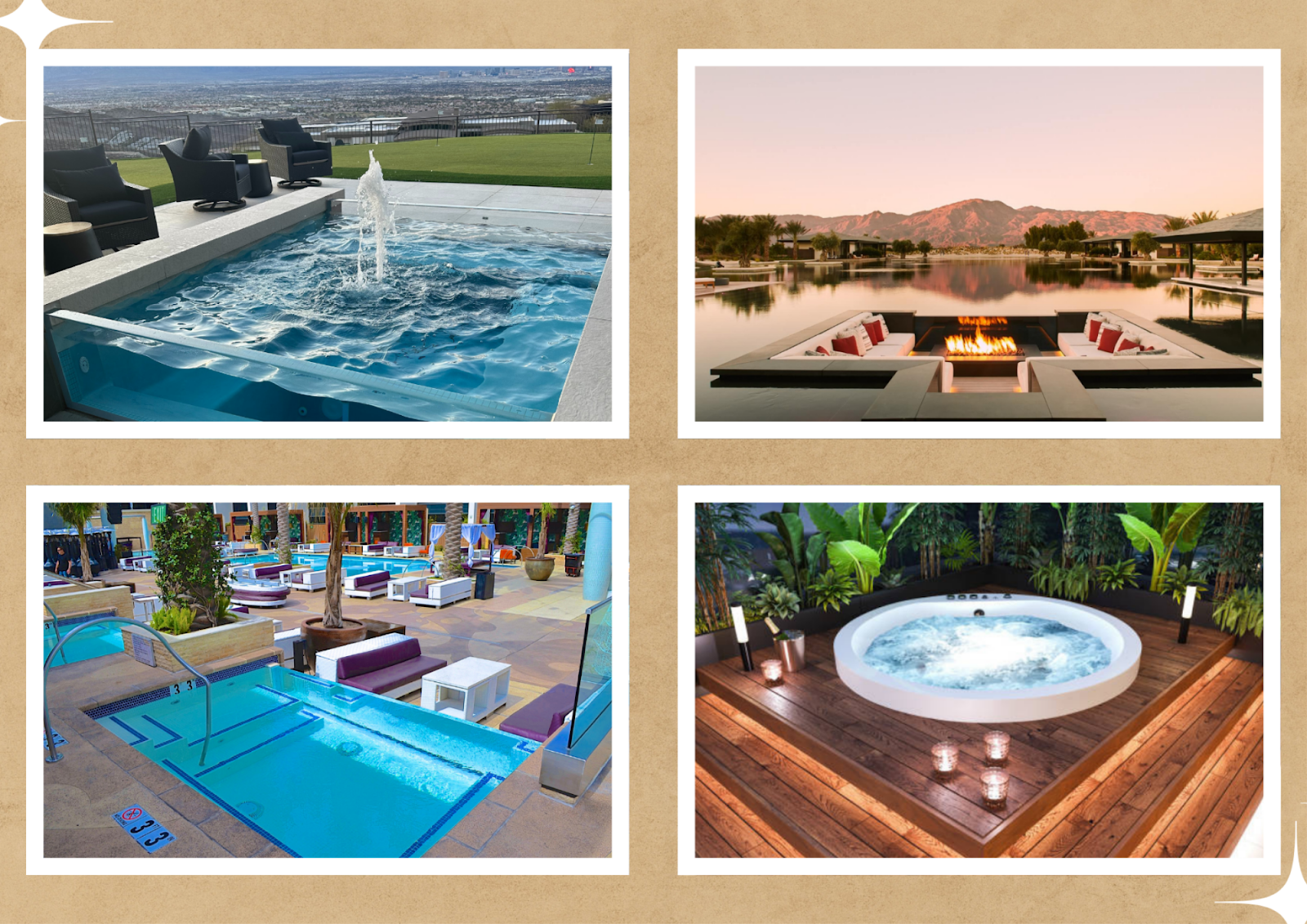
A swimming pool is often something you can be proud of, something that makes you feel accomplished and carefree. As a business (maybe a hotel or a resort), the swimming pool can be a prime selling point to attract more bookings. Or, you may simply want a pool to have a happy life with your family.
So, before you decide to have a pool built, you probably would want to know your options in terms of types of swimming pools, designs, and structures.
Yes, you can communicate with a professional to get recommendations, but I have often seen cases where a pool didn’t really match the surroundings or climate and had to be redone entirely.
And in most of these cases, those pools were recommended by professionals (but with less experience) to home/hotel owners who didn’t have much knowledge on what swimming pool type to get.
Now, today, I have decided to use my twenty years of experience to discuss 12 types of swimming pools that you can choose from depending on your needs and your place.
Though I personally specialize in luxury pools, I have worked on almost all types of pools over the decades. So you can be sure you will learn the right details, at least enough to be able to make a proper decision.
So, let’s get started.
Thinking of adding a swimming pool to your home, hotel, or rooftop space?
Before you dive in, remember: the type of pool you choose isn’t just about looks — it changes everything: cost, maintenance, usability, and even if you can add high-impact features like pool windows or dramatic infinity edges.
Over the years, designing luxury pools and custom pool window installations, we’ve seen how the right type of pool — matched to the location, climate, and usage — makes all the difference.
So, whether you want a kid-friendly splash zone or a jaw-dropping rooftop pool with see-through acrylic walls, here’s a complete guide to help you choose.
TL;DR: Swimming Pool Types At A Glance (And Why It Pays To Plan With Experts)
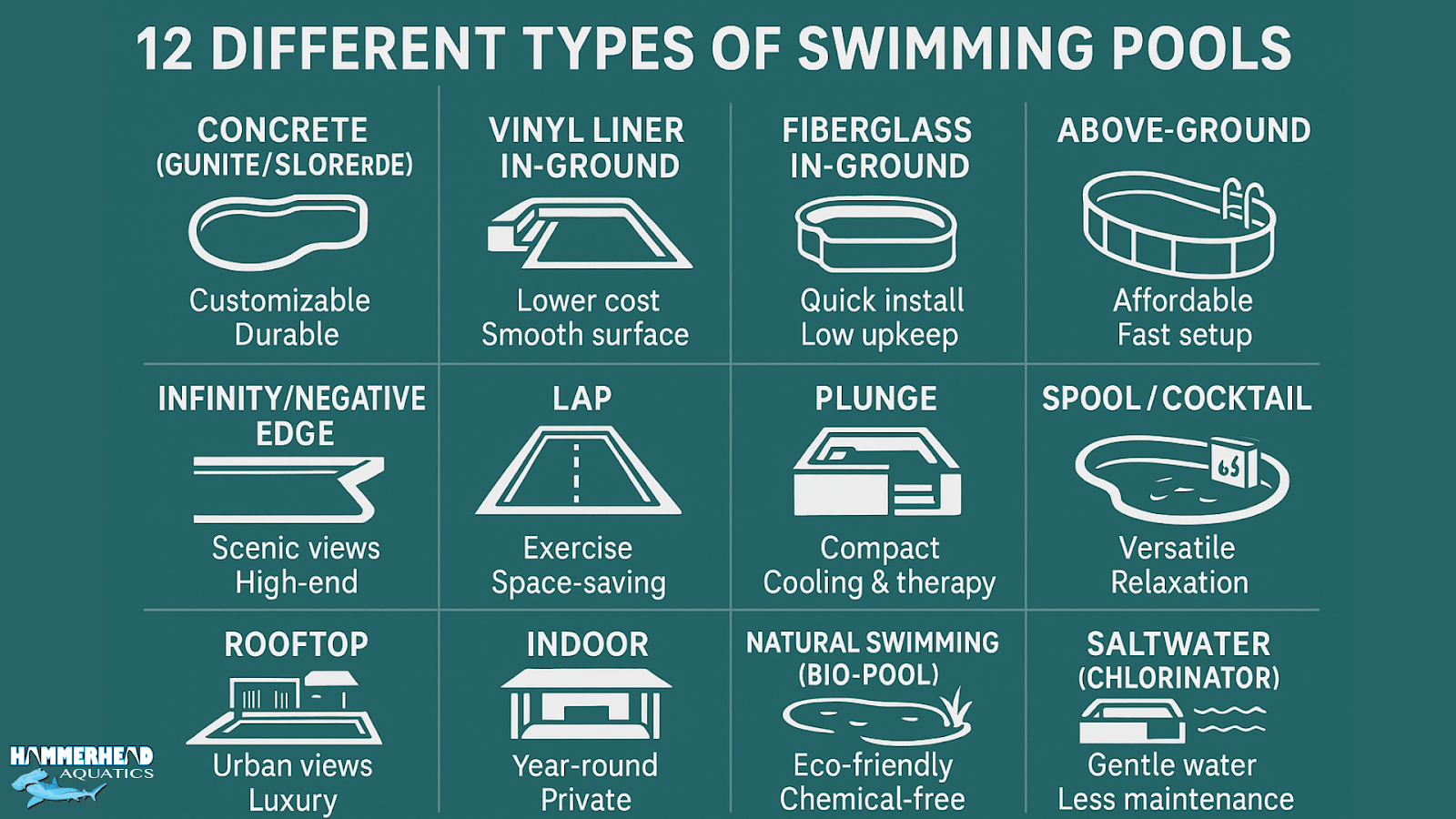
- With different types of pools, many things will vary in terms of:
- Cost
- Maintenance
- Usability
- Longeveity
- Material
- Type of pool windows it will suit, etc.
- Climate, local codes, and structural loads matter more than people realize.
- Kiddie pools are the cheapest and easiest to maintain, but only good for toddlers.
- Above-ground pools offer affordable, removable fun — perfect for DIYers on a budget.
- In-ground family pools come in any shape and add property value, but cost more to build and maintain.
- Lap pools are great for fitness-focused homeowners, especially in narrow yards.
- Indoor pools let you swim year-round and stay cleaner, but come with high install costs and humidity control needs.
- Olympic-size pools are only practical for serious athletes or clubs — huge space and maintenance required.
- Architectural pools turn the pool into an artistic statement, often paired with features like frameless pool windows.
- Infinity pools create stunning visuals with vanishing edges, especially on scenic sites.
- Natural pools blend swimming areas with planted regeneration zones, avoiding chemicals.
- Spools (spa + pool) suit small lots and social use, but are too small for real swimming.
- Saltwater pools are gentler on skin and avoid the chlorine smell, but come with a higher equipment cost.
- Plunge pools are compact cold-water retreats for therapy, not for laps.
- After you learn these, make sure to consult with a pool builder with high experience (such as Hammerhead Pools), who won’t ruin it for you.
Pro Tip: To get the most value (and beauty) out of your pool — especially if you plan pool windows, curved acrylic walls, or infinity edges — always consult experienced pool designers early.
Now, let’s dive into the details.
12 Types Of Swimming Pools Explained
Some pools may cost quite high, while some will be affordable but will come with more maintenance costs. Plus factors such as climate, local codes, and structural loads will come into play when you think of longevity.
However, once you read the details below, you will understand which pool type is within your budget or which one will require more maintenance, etc.
Let’s start.
1. Kiddie Pool: Small, Fun & Almost Maintenance-Free
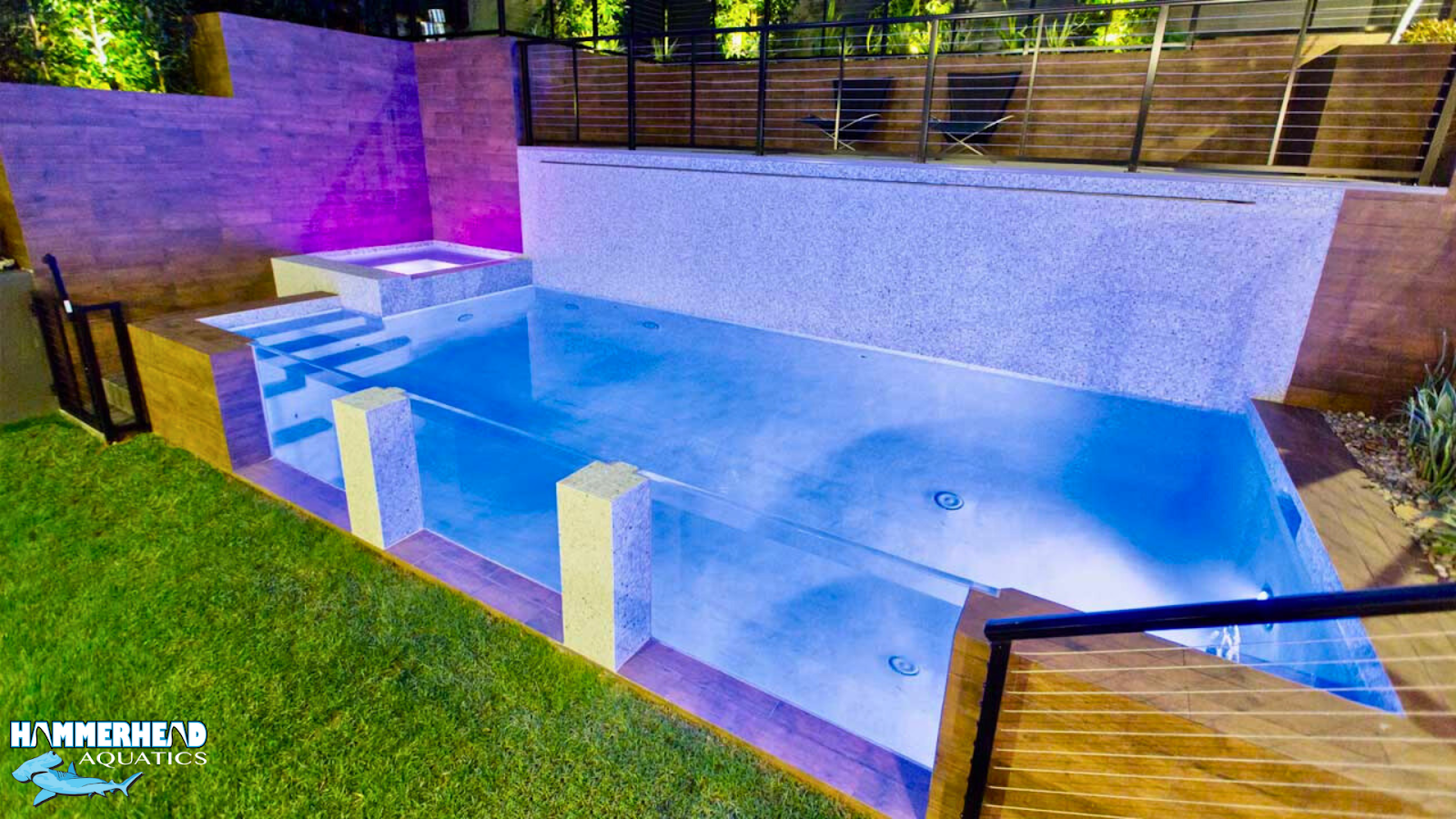
A kiddie pool might sound too basic, but if you have toddlers at home, they are the fastest way to beat summer heat. It’s an inflatable or molded plastic pool that you can buy at a very low cost. You may set it up in minutes, and you can drain & stash it away in the store room easily when not in use.
However, they’re too shallow to really swim for most adults. And you’ll need to empty them daily for hygiene.
Of course, you do not need any help from professionals for it. It’s just a quick option in case you are not ready with a good budget but want to offer your kids and family members a quick refresh.
Best for: Families with toddlers
Pros of a Kiddie Pool
- Easy to set up and portable
- Costs very less compared to a pool
- No exclusive maintenance required
Cons of a Kiddie Pool
- Need to change water manually (No filtration)
- Too swallow for a real swimming experience
- Small in size for most adults
Pro Tip: Luxury properties often keep a small kiddie pool on the deck to entertain toddlers safely while parents enjoy the main pool.
2. Above-Ground Pool: Budget-Friendly Backyard Swim
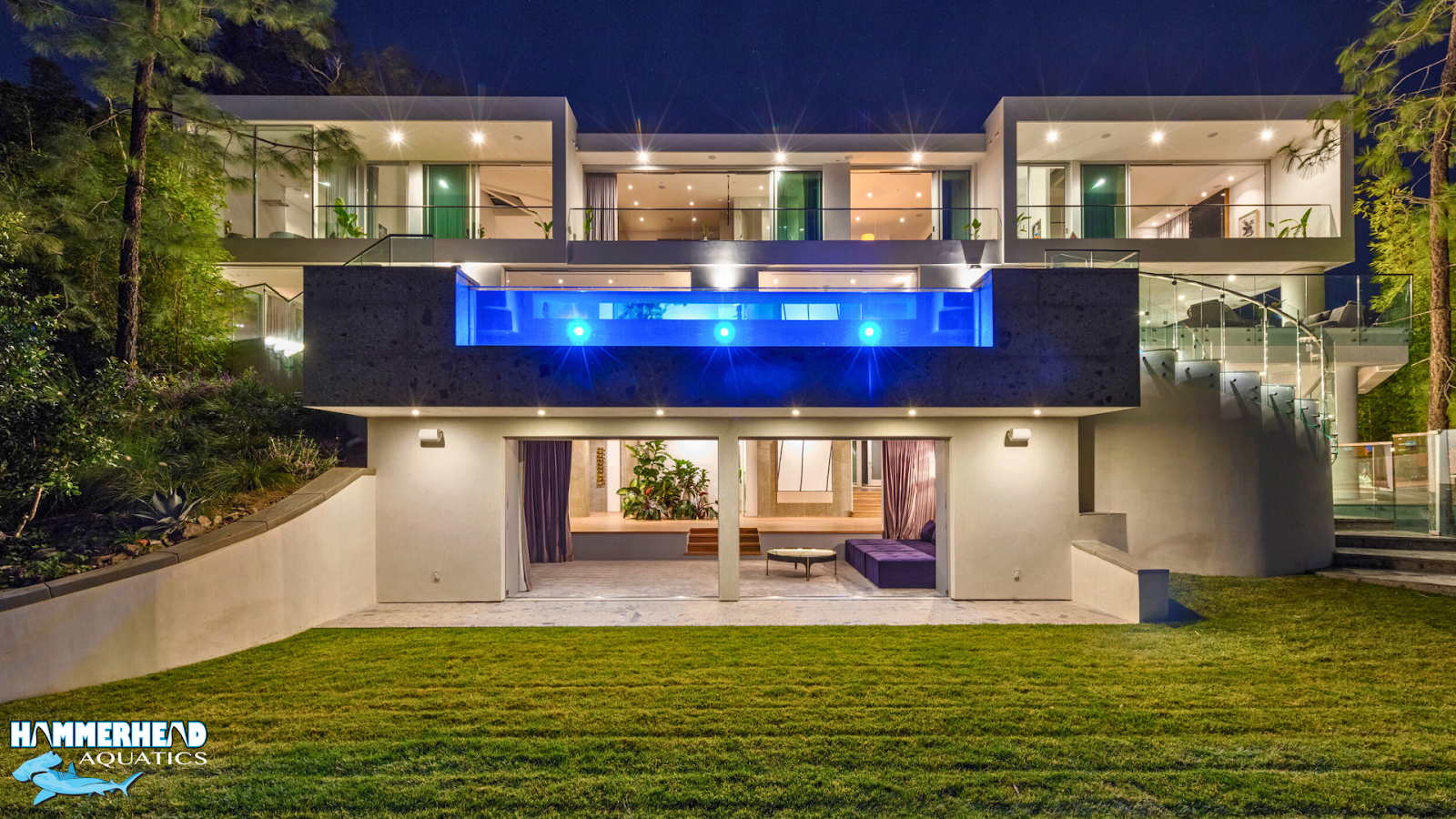
An above-ground pool is a swimming pool that sits on top of the ground, rather than being dug into it, usually made of steel, aluminum, or resin with a vinyl liner. Such pools bring backyard swimming to thousands of families every year.
With costs starting around $3,000–$7,000, they’re budget-friendly compared to in-ground options, and you can build wooden decks around them for a cleaner look.
Now, some above-ground pools can be moved and taken down when needed, and these pools are not that long-lasting. But they do serve as a fine alternative to an actual built-in swimming pool.
Best for: Owning a fully functional pool without the high costs, and a better swimming experience.
Pros of an Above-Ground Pool
- Full swimming experience without a costly pool building
- Often comes in soft and hard side options
- Can be taken down and moved
Cons of an Above-Ground Pool
- Needs to be maintained well to keep clear.
- Needs more space due to building the deck around the pool.
- Its liner must be protected from sharp objects to avoid leaks.
P.S. Some creative owners add small acrylic pool windows into the deck to keep an eye on kids and add a modern design touch. So, a mix of luxurious look and tradition in the same place.
3. In-Ground Family Pool: The Classic Choice
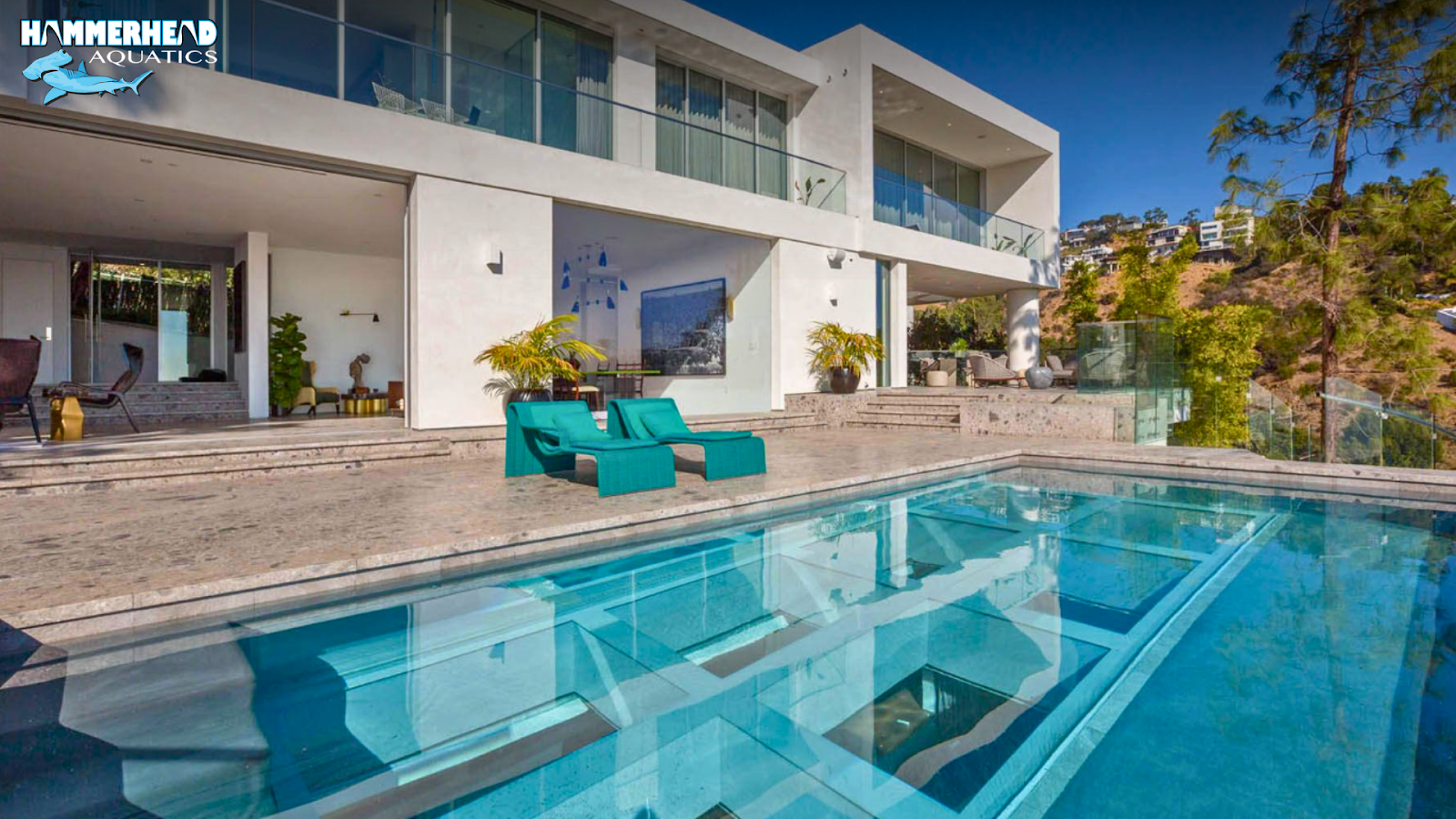
This is the classic, commonly built pool that you can build in your yard. They’re great for play, exercise, and entertaining, and can be customized with water features, tanning ledges, and even pool windows. Normally, the liners of these pools are built with concrete, fiberglass, or vinyl.
Their costs vary, starting at around $50,000 and can easily reach six figures for high-end pools based on their finishing, lighting, and water circulation automation. Plus, there will be preceding ongoing expenses for maintenance, repairs, and heating. But these are just part of the investment for having a great pool that can increase your property value and give you a better lifestyle.
Best For: Families/Resorts who want a multi-use recreational swimming pool for fun and entertainment
Pros of an In-Ground Family Pool
- Can be built in any shape
- You will get several finishing options
- Good for entertaining guests and family members
Cons of an In-Ground Family Pool
- Can get very expensive
- May require additional maintenance due to hidden plumbing
- Usually comes with a higher repair cost
Tip: A frameless or curved acrylic pool window can transform an ordinary in-ground pool into a luxury showpiece. So do consider adding one to yours.
4. Lap Pool: Slim, Practical, Fitness-First
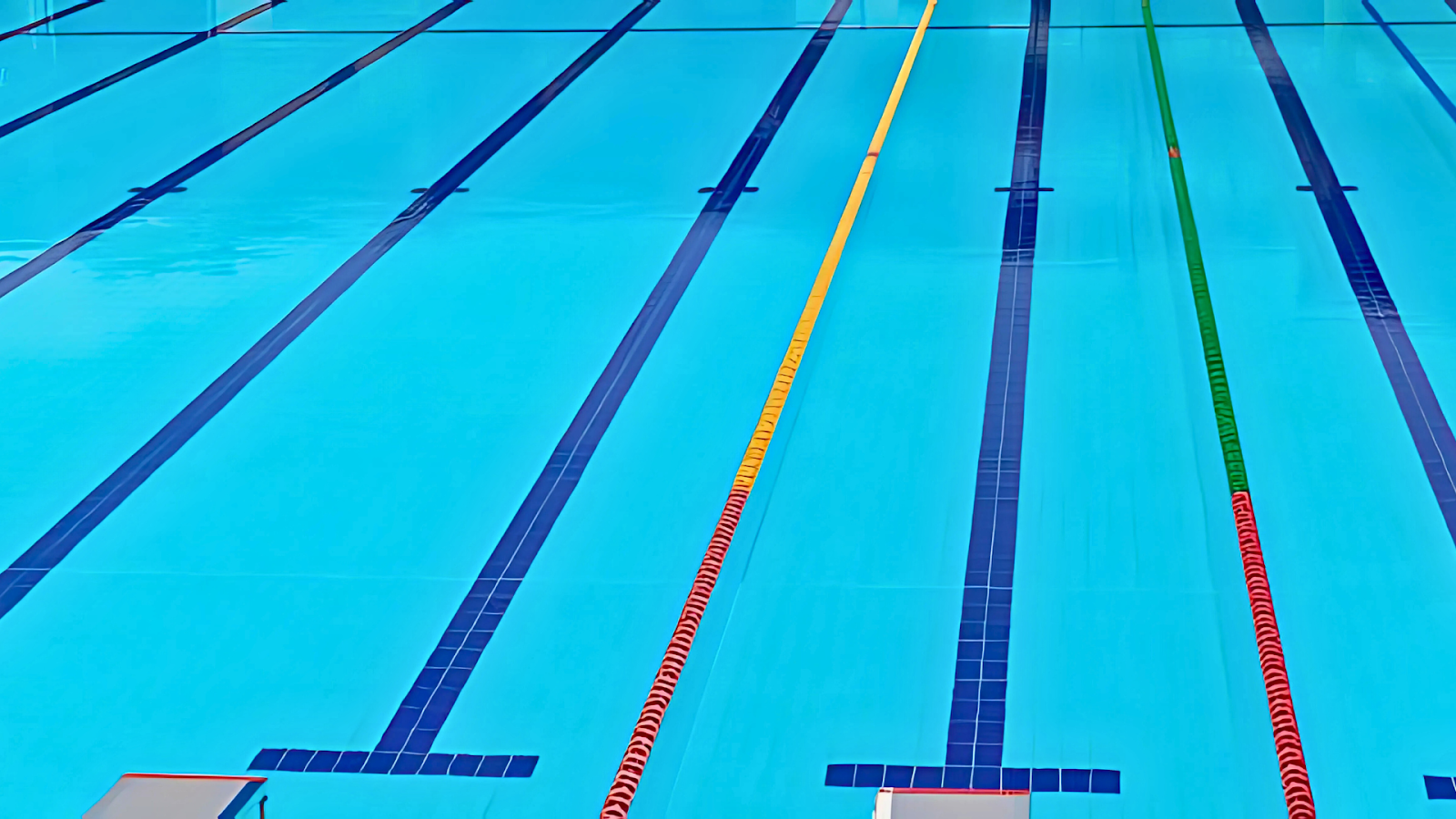
Lap pools are mainly built for fitness purposes. They are usually long (30–50 feet) and narrow (around 8 feet wide).
Whether you want a personal pool for swimming exercise or want a suitable pool on a narrow urban lot, a lap pool can be a great option.
These pools are not too deep and are mostly built in rectangular shapes.
Installing a lap pool may cost between $40,000-50,000, and like other pools, you will have regular maintenance costs.
Best For: Wanting a swimming pool for fitness purposes
Pros of a Lap Pool
- Ideal for swimming workouts and quick laps
- Such pools are perfect for Aerobics
- Can be built on narrow spaces
Cons of a Lap Pool
- Too shallow for regular swimming
- Narrow and not ideal for groups
- You can't use a diving board or water slides
5. Indoor Pool: Swim Any Time, Any Weather
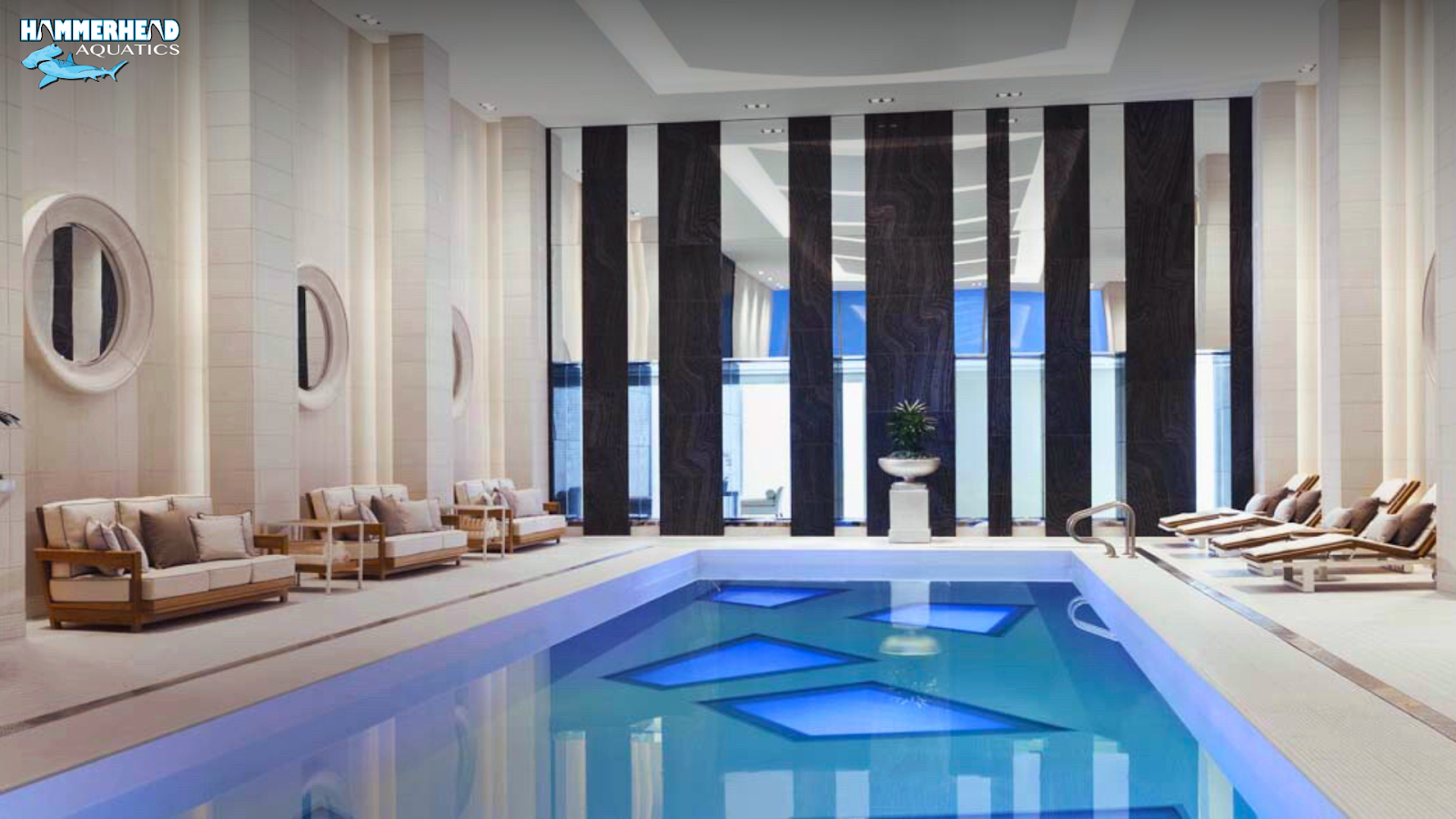
An indoor pool is a pool that you build inside a house or facility that’s under a roof with no exposure to the outside world. This means you can swim no matter when it rains or it’s too sunny. And you won't have to worry about debris, bugs, or leaves.
Such swimming pools are quite popular in places with cold climates or in luxury homes.
However, installing an indoor pool can cost quite a lot.
> Let's say you are setting up an in-ground swimming pool indoors. It will cost about $50,000 (just like a regular in-ground pool construction cost), plus an additional cost of $10,000 to $30,000 to create a glass enclosure to avoid pool water leakage.
There will be more things to set up, such as a dedicated space, vapor barriers, ventilation, and dehumidifiers to protect your home from mold and corrosion. These may cost more than $10,000-20,000.
Overall, you will need a hefty budget to build an indoor pool. But I'm sure, if you have a luxurious home, having an indoor pool will be more glamorous and not so much of a cost, but an investment in increasing your property value, and more importantly, your status.
(You can, however, choose to build an above-ground pool instead to cut down costs, but it will not feel as luxurious.)
Best For: Fitness centers, sports centers, hotels & resorts, luxurious homes
Pros of an Indoor Pool
- Can be used during all seasons, year-round
- Has lower heating costs
- Great for training, but also for indoor luxury
Cons of an Indoor Pool
- Comes with high maintenance costs
- High investment for installation
- Creates a humid environment, leading to corrosion of indoor walls
Design tip: You can consider adding a curved acrylic wall connecting the pool to living areas to create a stunning visual feature.
6. Olympic-Size Pool: For Athletes & Clubs
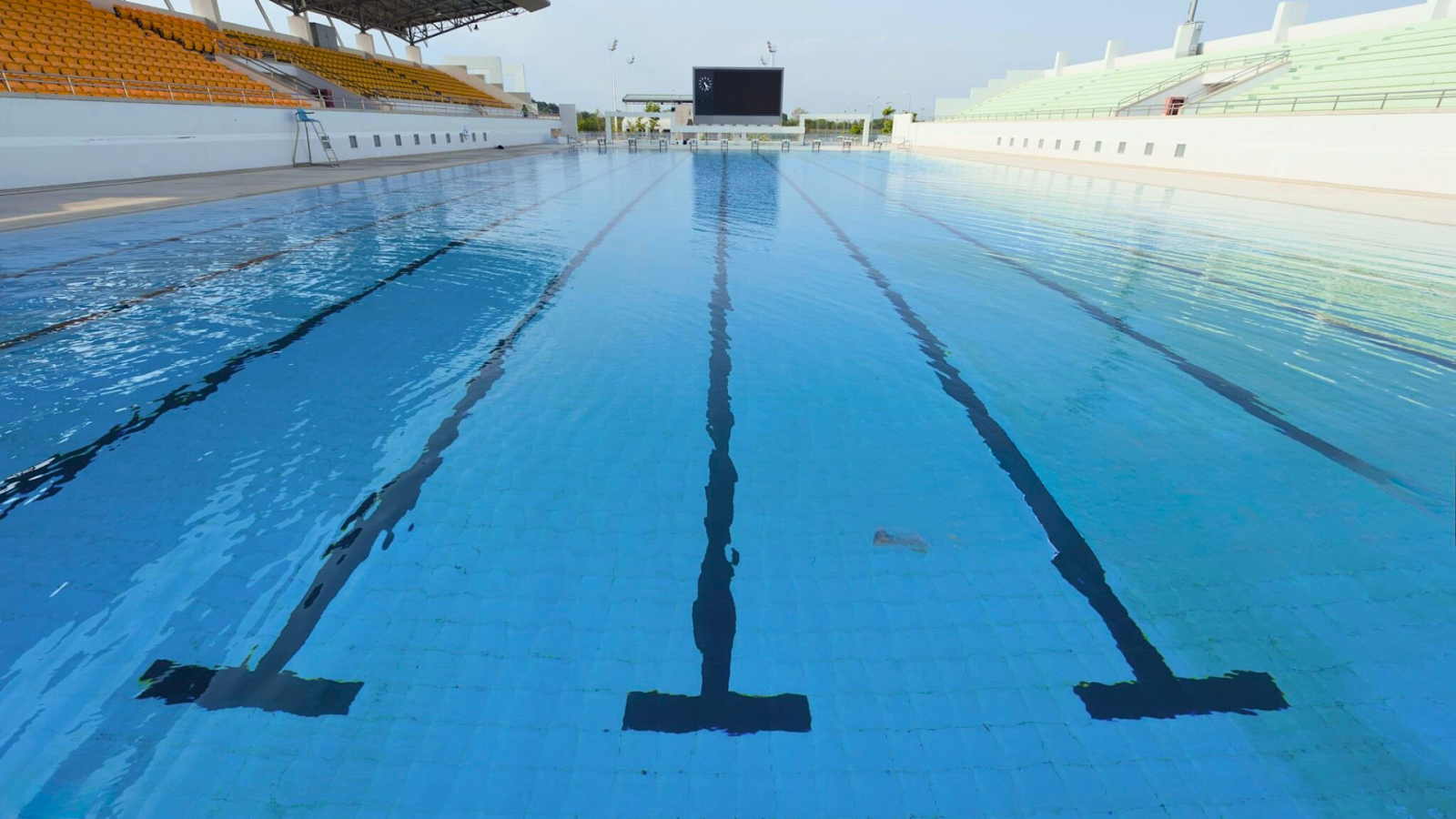
An official Olympic pool is huge — 50 meters long, 25 meters wide, holding roughly 500,000 gallons of water. But if you are planning a pool for your home, then you probably wouldn’t want such a large pool.
However, if you own a sports center, a professional club, a school, or if you are a rich swimming athlete who wants a personal training pool, then yes, this is what you need.
But who am I to limit this? As a homeowner, if you have the land, budget, and passion for competitive swimming, then go ahead and get one set up.
An Olympic-sized Pool can easily cost over $300,000, and a huge regular cost for maintenance.
Best For: Fitness centers, sports centers, schools, clubs, and athletes
Pros of an Olympic-Size Pool
- Best option for athletes & sports centers
- Usually built at facilities where events are held
- Can be used commercially to offer swimming training
Cons of an Olympic-Size Pool
- Too large, not ideal for a regular home
- High cost of construction
- Increased maintenance costs and efforts
7. Architectural Pool: Design Over Everything
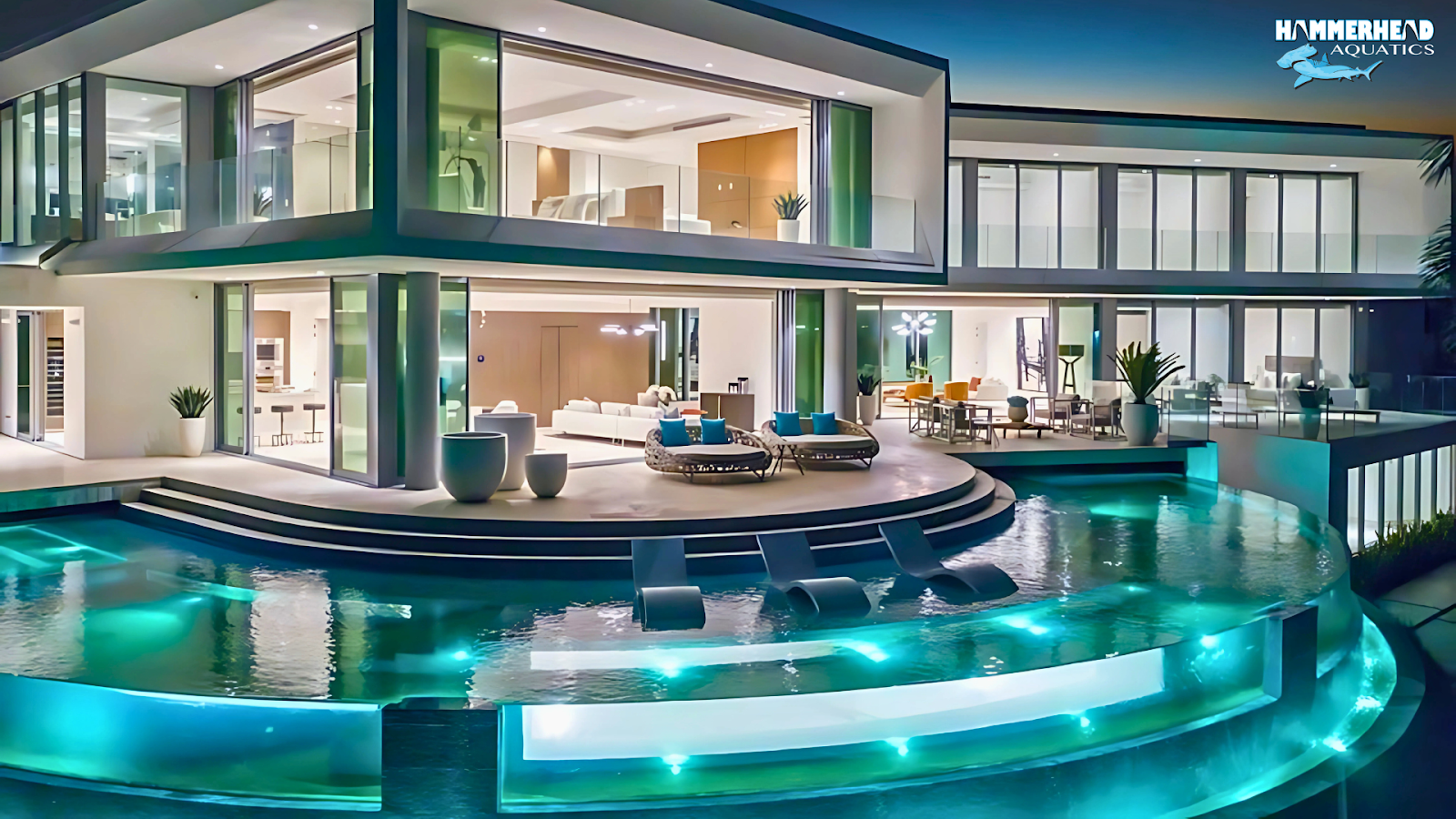
Architectural pools are usually geometrically sophisticated swimming pools planned by architects to fit and blend with the house. They come with clean lines, structured shapes, and use matching materials for a unified look.
When planning to build a custom home, you can include the requirement to have a swimming pool built along with the home construction. So, you can give the architects the responsibility to decide the shape and design of the pool.
Now, even though the maintenance cost is similar to any in-ground pool, if you really want to blend it well with your property in a luxurious manner, the costs can go well over $100,000.
Do keep in mind, you need a highly experienced pool builder to pull it off. Most pool builders do well when they plan the whole thing. But when planned by architects, only experienced pool building teams will be able to point out flaws and suggest better pool construction changes.
I once had one of my friends call me for advice with a pool design suggested by architects. It had some large curves which made little sense.
Thanks to my experience, I was able to point out areas that looked well on paper, but would be horrible once constructed. Eventually, I recommended the right materials and suggested a little change in the curved areas of the pool. That was a successful project and to this day, he often calls me if he gets confused.
If you want my help, you may contact my company, Hammerhead Pools.
Best For: Planned swimming pools for luxurious homes before construction.
Pros of an Architectural Pool
- Such pools tend to be aesthetically pleasing
- The size and design match the overall property design
Cons of an Architectural Pool
- It can get very expensive for construction
- May require hiring additional experts for construction
- Often planned for the outlook, but without a focus on function
Tip: Consider requesting architects to plan a pool window to be included for a more luxurious outlook.
8. Infinity Pool: The Scenic Showstopper
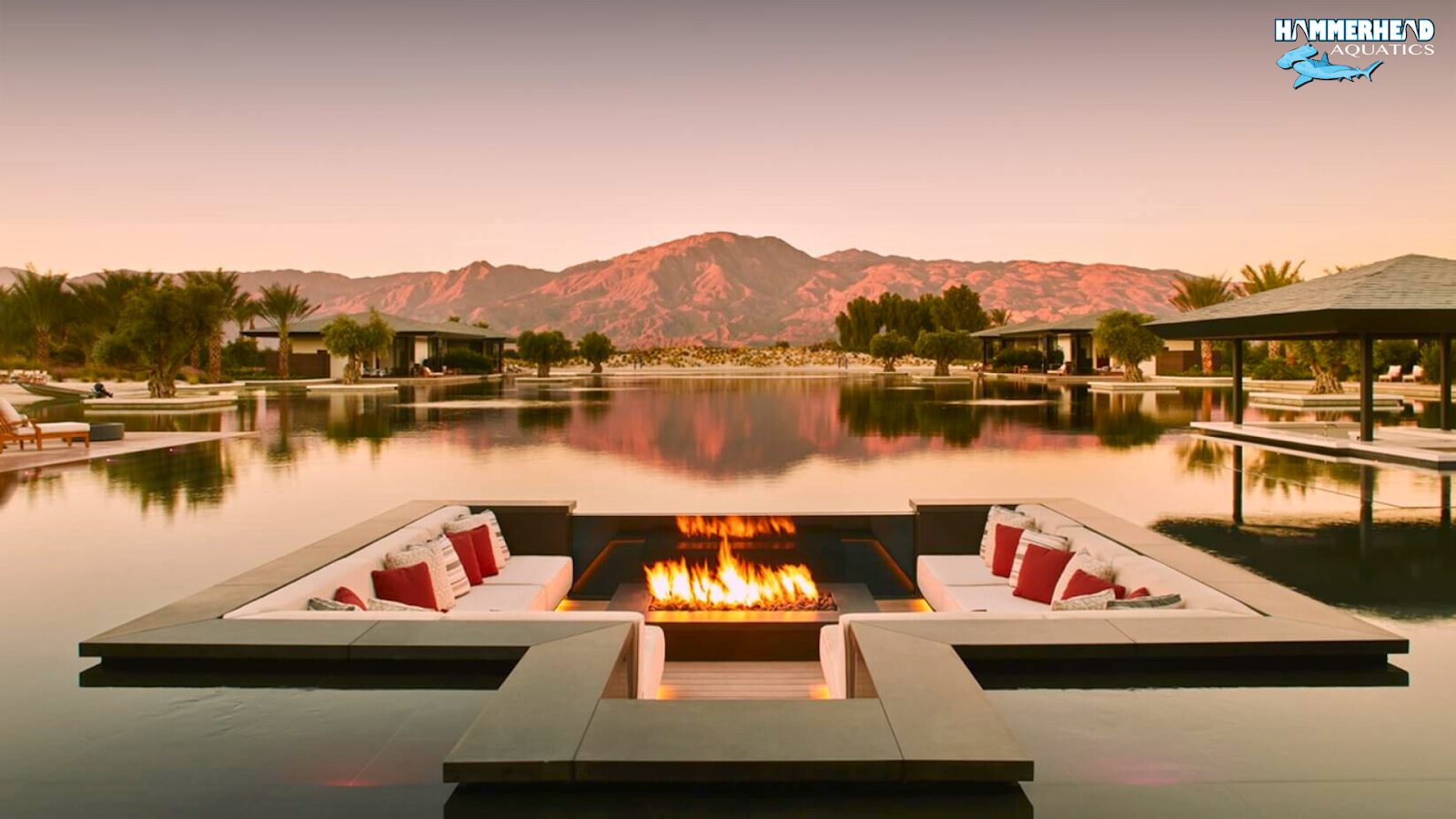
Infinity (or vanishing edge) pools use precise engineering to let water spill over one edge, merging with the landscape or skyline.
They’re perfect on sloping sites overlooking the ocean, city, or forest. Building a pool with infinity edges may bump up the cost to a range of $55,000 - $85,000.
Plus, infinity pools require extra tanks, pumps, and structural requirements, which can add to the cost.
Best For: Rooftop pools, Resorts & Hotels with built-in pools.
Pros of an Infinity Pool
- The pool easily blends with the sky or seawater (from a POV angle)
- Gives a unique, high-standard look
- Can be any size and shape
Cons of an Infinity Pool
- Very expensive to build
- Needs custom construction
- Usually needs a drop-off for the desired effect
Design Tip: Combine an infinity edge with a transparent acrylic wall for jaw-dropping views. This is quite popular in luxury villas and rooftop pools.
9. Natural Pool: Eco-Friendly & Unique
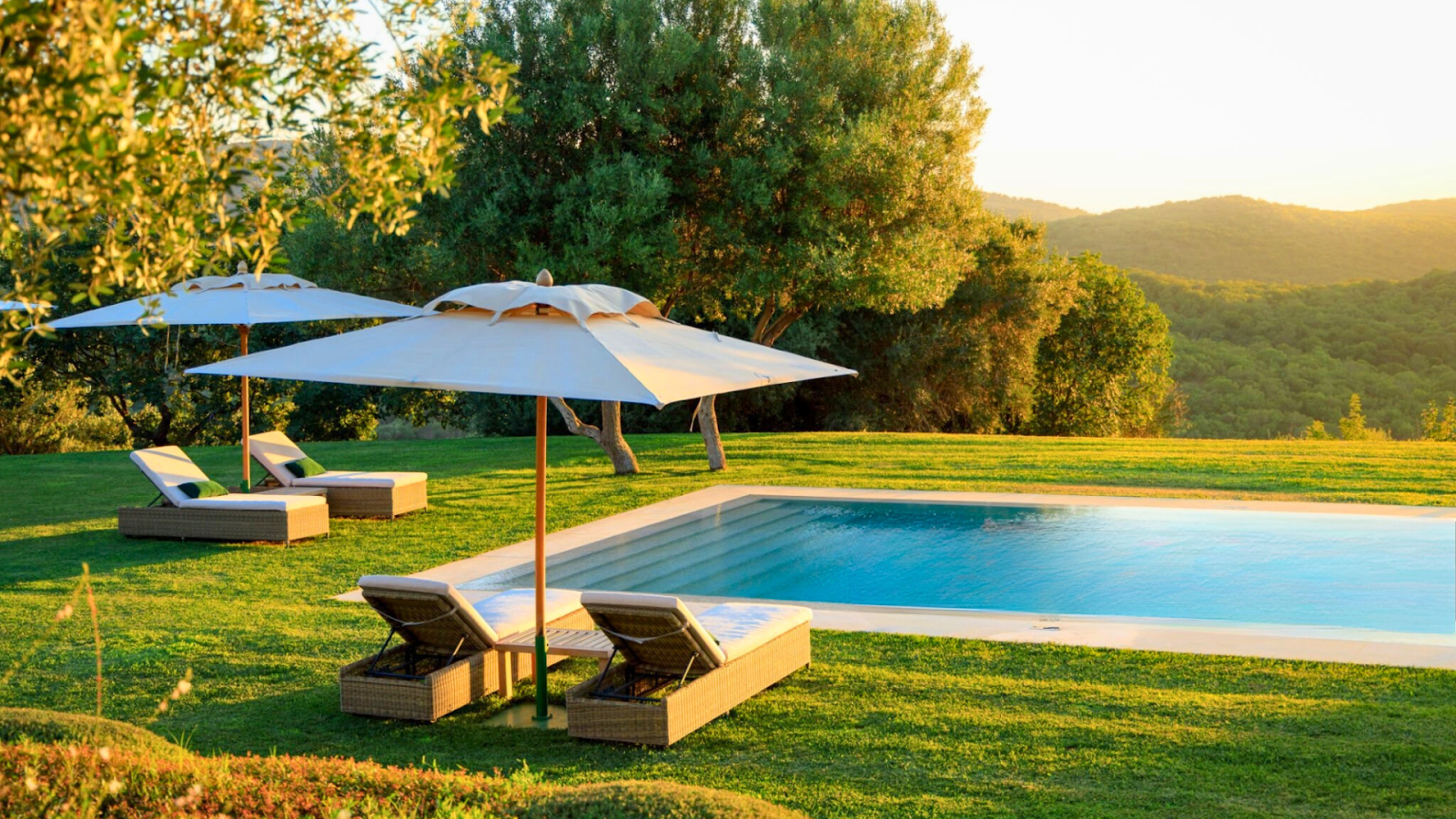
Natural pools look like ponds. They are built around a separate “regeneration zone” with plants and gravel to clean the water instead of chlorine.
Such pools can easily blend with rustic homes, eco-resorts, and gardeners wanting wildlife-friendly swimming.
But balancing the water quality can be tricky, and you might occasionally see algae or cloudiness.
They cost as much as — or more than — a regular in-ground pool, depending on landscaping.
Building a natural swimming pool can cost between $75000-$150,000, i.e., it is on the expensive side.
Pros of a Natural Pool
- The pool is self cleaning
- Build on any shape
- Gives a natural feel, often blended with the surroundings.
Cons of a Natural Pool
- Very expensive to build
- Needs custom construction
- Usually needs a drop-off for the desired effect
Design Tip: Combine an infinity edge with a transparent acrylic wall for jaw-dropping views. This is quite popular in luxury villas and rooftop pools.
10. Spool: Spa Meets Pool
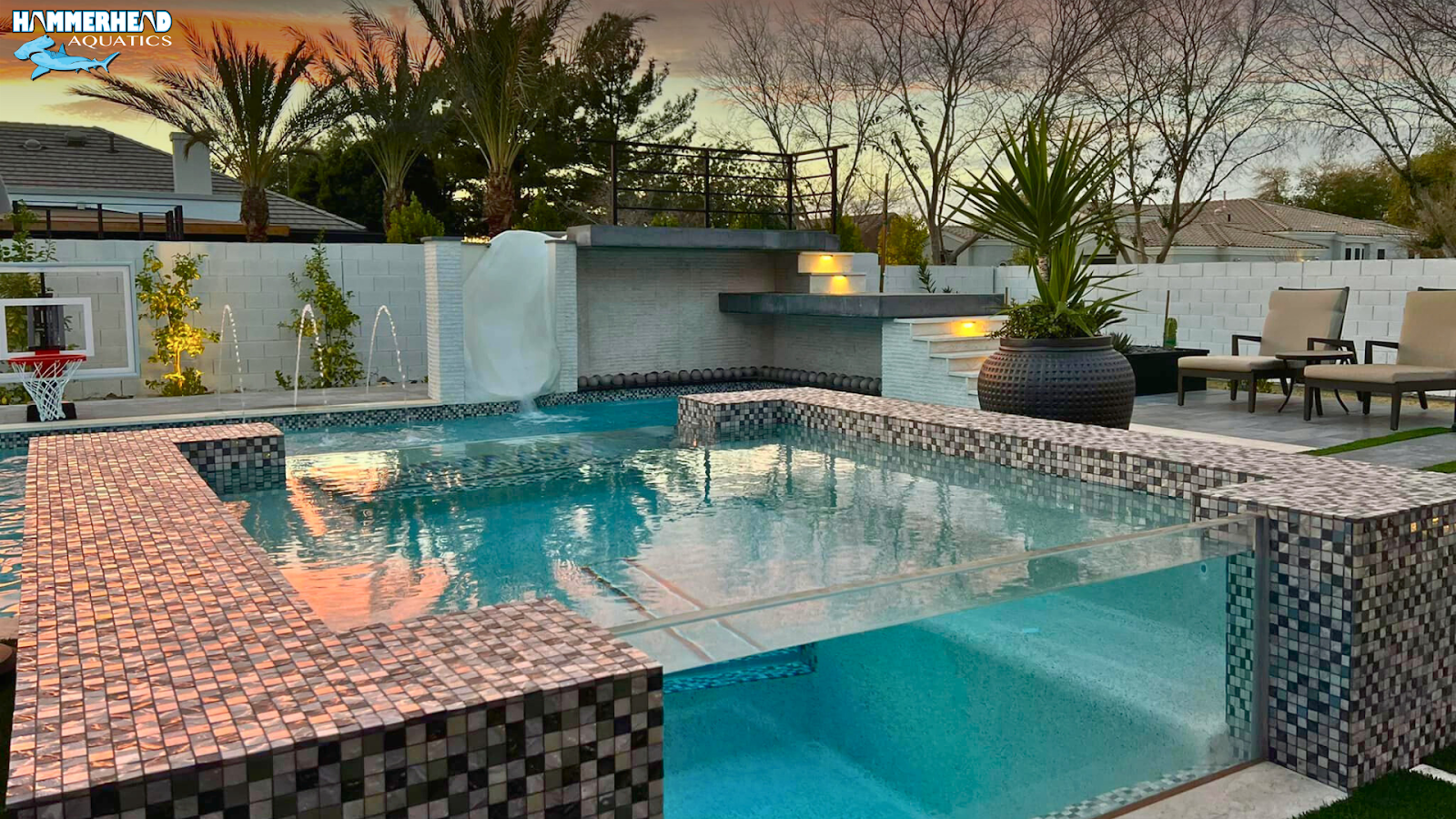
Part spa, part pool: a “spool” is larger than a hot tub but smaller than a swimming pool. Many include jets for gentle resistance swimming or massage.
They’re ideal for smaller yards, social gatherings, or relaxing soaks — but too small for serious laps.
Typical costs range from $5,000–$20,000, depending on design and features.
Best For: Social gatherings, luxurious hotels & resorts
Pros of a Spool
- Great for relaxing and socializing
- More affordable than a full-size pool
- Can incorporate a surrounding deck
Cons of a Spool
- Smaller in size
- Not big enough for adults to swim
- Shallaw, i.e., not ideal to dive or swim naturally
11. Saltwater Pool: Gentler Water
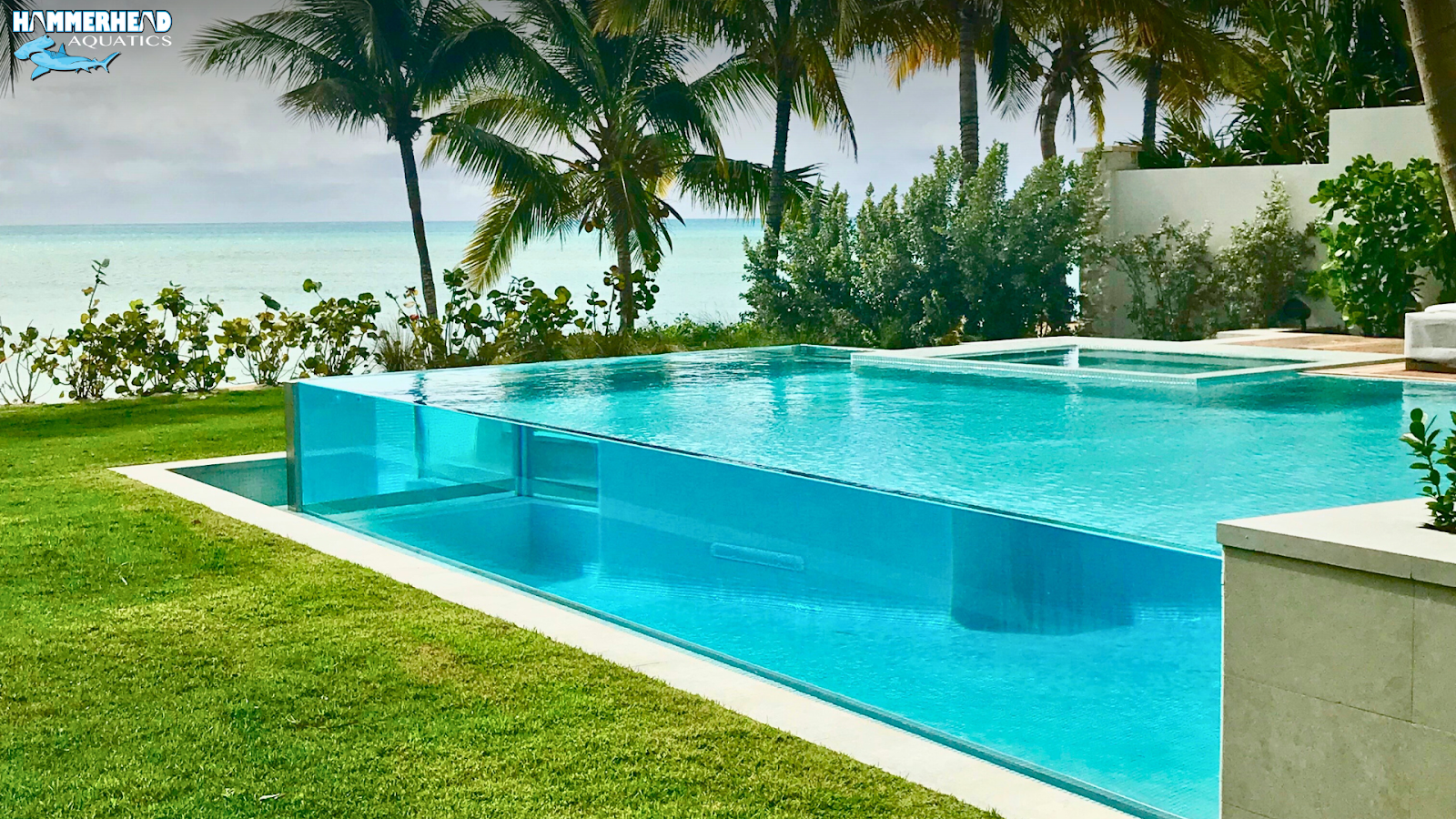
Saltwater pools are pretty common near any beach. In such pools, the water is rather saltwater from the sea. To handle it a dedicated tool can be used to turn the salt in water into chlorine.
They’re popular with swimmers sensitive to chemicals. But initial setup costs more, the generator needs upkeep, and salt can corrode some pool equipment and stonework.
Saltwater pools may cost as low as $12,000, but can cost up to $40,000 depending on what additional features you want on the swimming pool.
Best For: Resorts and hotels near beaches, Luxury homes near the sea
Pros of a Saltwater Pool
- Great for chlorine allergies
- Avoids chlorine
- No chlorine smell
Cons of a Saltwater Pool
- Higher maintenance cost
- More difficult to chemically balance water
- Expensive to repair components
12. Plunge Pool: Cold Therapy Niche
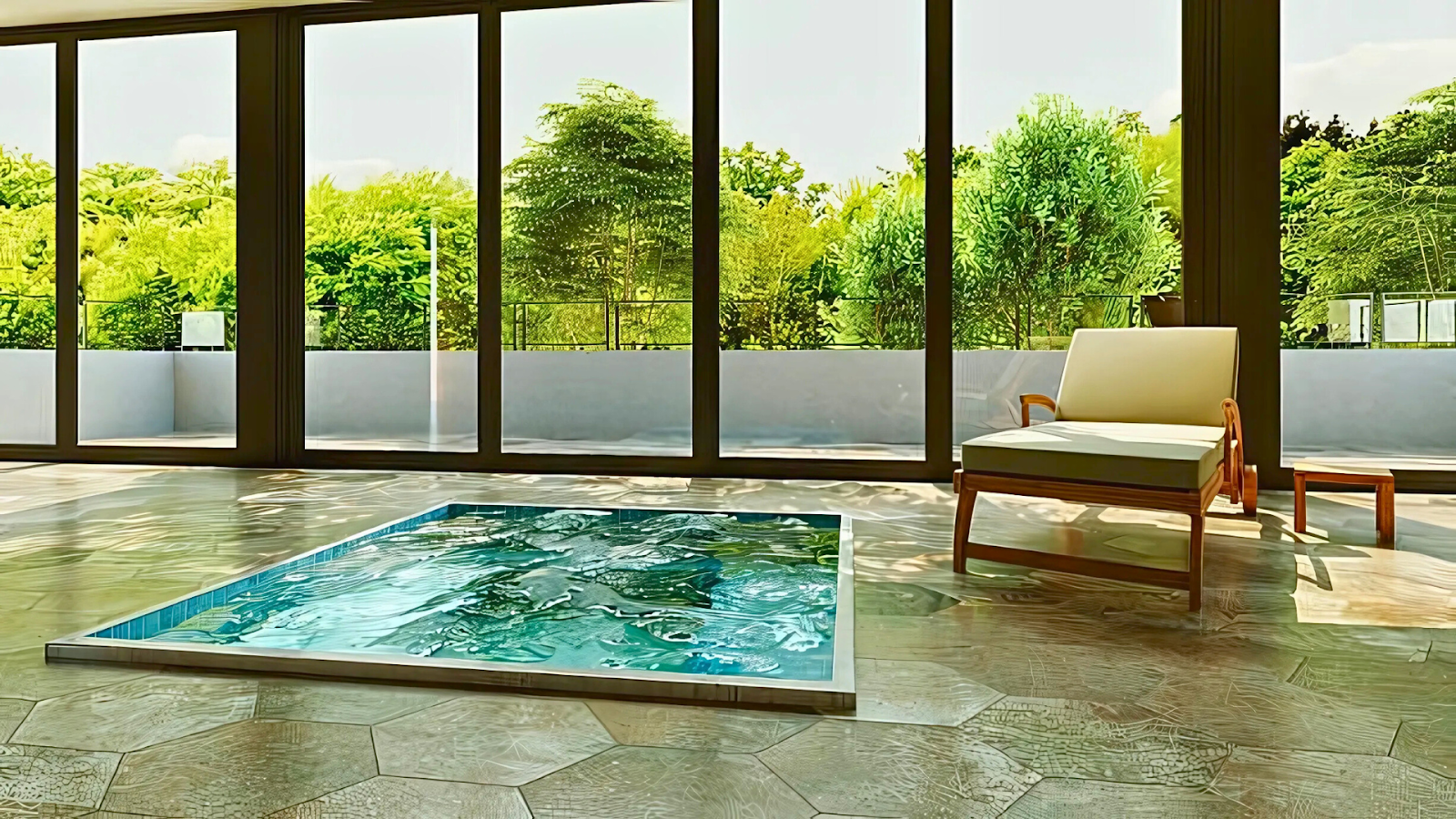
Plunge pools are small, deep pools kept cold; perfect after saunas, workouts, or just to cool off on hot days.
They’re too small for swimming laps but great for quick dips. Costs vary but generally range from $10,000–$35,000.
Often paired with larger pools or spas in luxury designs.
Best For: Athletes
Pros of a Saltwater Pool
- Therapeutic
- Can be incorporated into a normal pool
- Health benefit
Cons of a Saltwater Pool
- Small in size
- No heating system
Quick Comparison Table: 12 Pool Types at a Glance
Here’s your table rewritten as clear, point-wise bullets (wording preserved):
- Kiddie Pool
• Best for: Toddlers
• Pros: Cheap, portable, no upkeep
• Cons: Not swimmable, drains often - Above-Ground
• Best for: Budget family fun
• Pros: DIY-friendly, removable, lower cost
• Cons: Less aesthetic, liner care, space need - In-Ground Family
• Best for: Versatile use
• Pros: Custom shapes, value add, entertaining
• Cons: Higher cost & upkeep - Lap Pool
• Best for: Fitness, narrow yards
• Pros: Workout use, long & slim
• Cons: No slides/diving, limited fun use - Indoor Pool
• Best for: Year-round swimming
• Pros: Weatherproof, clean
• Cons: High build cost, humidity management - Olympic-Size
• Best for: Training, clubs
• Pros: Large scale use, can divide lanes
• Cons: Massive size, cost & maintenance - Architectural
• Best for: Design-focused homes
• Pros: Stylish, cohesive design
• Cons: Higher cost, form over function - Infinity Pool
• Best for: Scenic sites
• Pros: Dramatic view, luxury feel
• Cons: Expensive, needs drop-off site - Natural Pool
• Best for: Eco-lovers
• Pros: Chemical-free, blends landscape
• Cons: Complex balancing, algae risk - Spool
• Best for: Small lots & socializing
• Pros: Warm soaking, affordable, compact
• Cons: Too small for swimming, shallow - Saltwater Pool
• Best for: Chlorine-sensitive owners
• Pros: Gentler water, no chlorine smell
• Cons: Costly equipment, corrosion risk - Plunge Pool
• Best for: Cold therapy
• Pros: Compact, health benefits
• Cons: Always cold, not swimmable
Final Thoughts: More Than Just a Pool
Having the right type of swimming pool, especially paired with smart features like pool windows or infinity edges, transforms your yard or rooftop into a true lifestyle centerpiece.
If you want crystal-clear views and scratch-resistance, glass pool windows may be best. But if you dream of curved or panoramic see-through panels (especially in warm climates), acrylic pool windows are lighter, customizable, and easy to polish back if scratched.
Infinity edge and frameless pool window designs take it even further — but only when engineered by specialists. These dramatic effects don’t just happen; they need expert planning around water pressure, framing, and structural safety.
Remember: each choice has its pros and trade-offs, so plan ahead.
Pro Advice: Always Consult With Experts Before Building Your Pool
- Adding pool windows, infinity edges, or architectural features isn’t just an add-on — it changes the entire engineering and cost.
- By involving experienced pool designers and engineers early, you’ll avoid expensive mistakes and ensure your pool looks and performs exactly how you imagine.
Expert Pool Window Design & Installation
If you’re planning a luxury pool, rooftop pool, or transparent viewing wall, talk to our team.
With over two decades of experience, we’ve delivered stunning installs in everything from boutique hotels to oceanfront villas.
We don’t just design for beauty — we plan for safety, structural integrity, and real-world budgets.
Book a call, tell us your vision, and we’ll share a free quote or practical alternatives that fit your site and style. (Contact Us)
Even if you’re still exploring, we can help you figure out:
- Whether pool windows make sense for your design and climate
- The best material (acrylic or glass) for your goals
- How large or small your window can safely be
Feel free to comment below or contact us — we reply with clear, experience-backed advice to help you plan smarter.
FAQs About Types of Swimming Pools
1. Which pool type is easiest to maintain?
Kiddie pools, because you just drain and refill. Among larger pools, smaller above-ground pools are easier than large in-ground pools.
2. Are infinity pools only for luxury homes?
Mostly, they cost more and need a drop-off site. But even small pools can add a mini infinity edge on a slope.
3. Can I add pool windows to any pool type?
Technically, yes, but pool windows need engineered framing and planning. Acrylic windows work best for curved or long panels.
4. What’s better: acrylic or glass pool windows?
Acrylic is lighter, can curve, and is polishable if scratched. Glass is heavier, stays clearer longer, and resists scratches.
5. Can an above-ground pool look stylish?
Yes! Add a surrounding deck, creative lighting, and even a small acrylic viewing panel for a modern look.
From lap and plunge pools to infinity edges and natural systems, each swimming pool type offers a different balance of space, budget, upkeep, and experience. Start by clarifying your goals (fitness, family fun, visual impact), then match them to site constraints, climate, and maintenance expectations. Choose a structure (concrete, fiberglass, or vinyl) and water system (chlorinated or saltwater) that fit your lifestyle and long-term costs. For a design that looks great and performs for years, consult an experienced builder early—Hammerhead Aquatics can help you evaluate options and deliver a custom plan from concept to completion.











